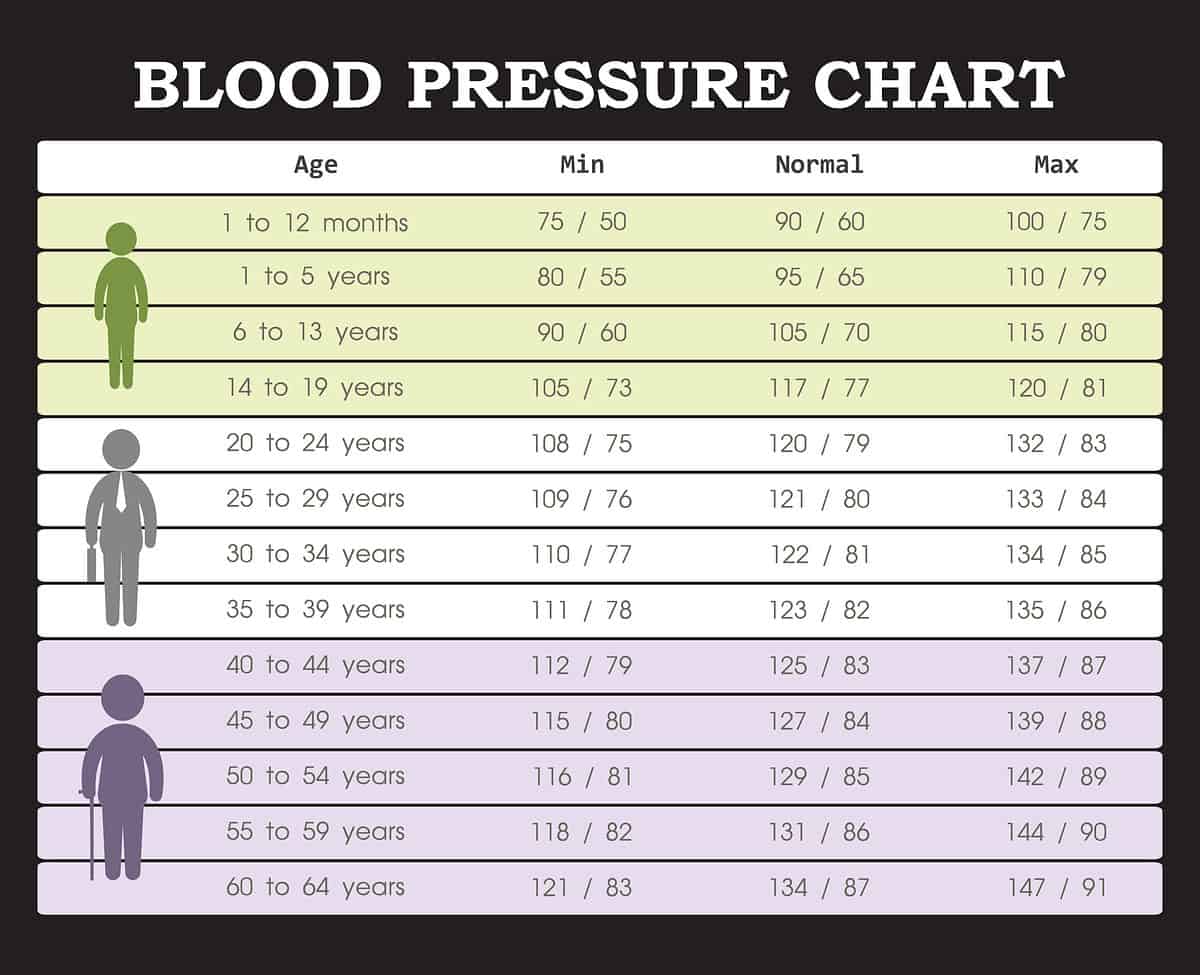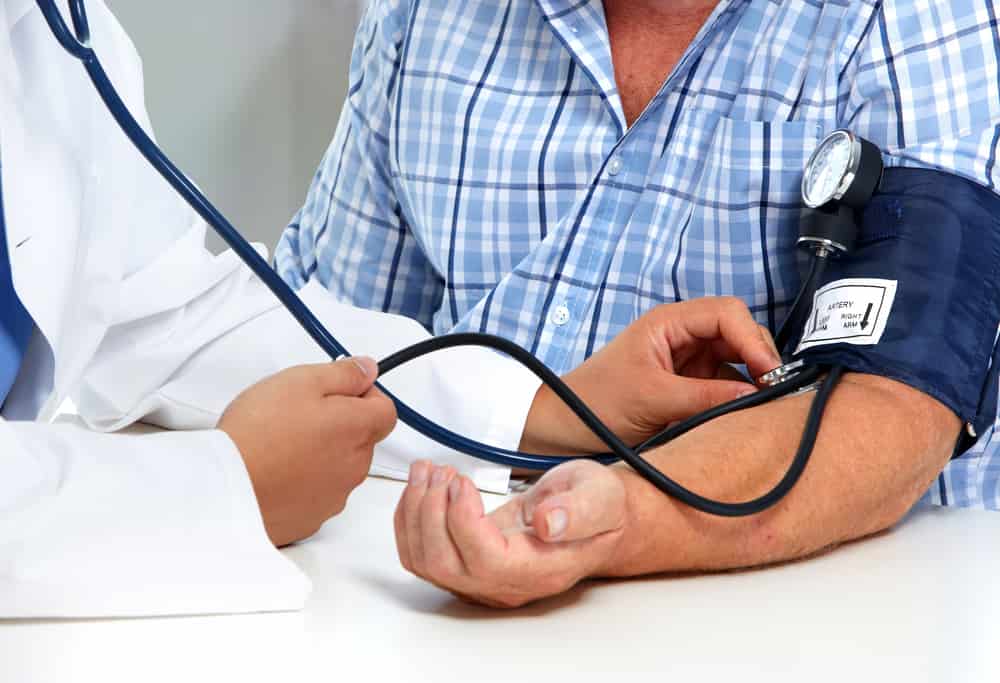Key Points
- A variety of risk factors can contribute to the development of high blood pressure, including age, weight, lifestyle, and race/ethnicity.
- Blood pressure is the force exerted by blood against artery walls.
- This simple blood pressure chart is easy to use
- Low blood pressure, known as hypotension, can be dangerous because not enough oxygen is getting delivered to the brain and other essential organs.
Blood pressure (BP) is the force that blood exerts on the blood vessels as it courses through our bodies. It is crucial to heart health: an increase in blood pressure is strongly associated with an increase in cardiovascular disease risk, even when BP is within the normal range.
When your blood pressure rises, this causes stress in your blood vessels and heart. If it remains too high, also called hypertension, you are more likely to suffer from kidney disease, eye damage, vascular diseases, strokes, heart attacks, and other complications.
The pressure on the blood vessel walls decreases as your blood pressure falls. If it remains too low (hypotension), critical parts of your body, such as the brain and heart, may not receive enough oxygen.
A variety of risk factors can contribute to the development of high blood pressure.
- Family History: A family history of high blood pressure has a link to nearly 100 genetic variations. While having a family history of high blood pressure increases your risk, the exact pattern of genetic inheritance is unknown
- Age: Blood pressure tends to rise with age, as explained in the blood pressure chat below
- Weight: People who are overweight are more likely to develop high blood pressure
- Lifestyle: Excess sodium (salt), insufficient potassium, insufficient exercise, excessive alcohol consumption, and smoking can all contribute to high blood pressure
- Sex: Males are more likely than females to develop high blood pressure before the age of 55 Females are more likely to develop it after the age of 55
- Race/ethnicity: Black adults are more likely to have high blood pressure

©vectorscore/Shutterstock.com
What is Blood Pressure?
Blood pressure is the force exerted by the blood against the artery walls. Each heartbeat generates force as blood is pumped from the heart into the blood vessels. This is referred to as systolic blood pressure. Blood pressure is also affected by the size and elasticity of the artery walls. Pressure is created inside the arteries every time the heart beats (relaxes and contracts). When the heart is relaxed, the arteries maintain some pressure in the artery by remaining at a lower resting tone. This is referred to as diastolic blood pressure.
Blood pressure is said to be high when the blood force is too great during heart relaxation or contraction within the arteries. The arteries may experience increased resistance to blood flow. This makes your heart work harder to circulate blood.
The Function of Blood Pressure in the Body
Circulation is analogous to a sophisticated form of plumbing in that blood has “flow,” and arteries are “pipes.” Blood flow is caused by a fundamental physical law, which also holds true in a garden hose pipe.
A difference in pressure causes blood to flow through the body. Blood pressure is highest at the beginning of its journey from the heart – when it enters the aorta – and lowest at the end of its journey along progressively smaller artery branches. The pressure difference is what causes blood to flow.
Arteries influence blood pressure in the same way that the physical properties of a garden hose influence water pressure. Pipe constriction raises pressure at the point of constriction.
Without the elastic nature of artery walls, for example, blood pressure would fall faster as it is pumped from the heart.
While the heart generates the most pressure, the arteries play an equally important role in maintaining it and allowing blood to flow throughout the body.
Blood pressure and flow are affected by artery conditions, and narrowing of the arteries can eventually block the supply completely, leading to dangerous conditions such as heart attack and stroke.
How is Blood Pressure Measured?

©kurhan/Shutterstock.com
A sphygmomanometer is used to measure blood pressure. It is made up of a rubber armband – the cuff – that is inflated with a hand or machine pump, and a stethoscope used by a nurse or other healthcare provider. You can also use an electronic blood pressure monitor to take your blood pressure. Most pharmacies will have one.
When taking blood pressure, two numbers are usually recorded:
- The top number represents systolic pressure. When the heart contracts and pumps blood through the body, this is the pressure inside the artery
- The diastolic pressure appears at the bottom. When the heart is filling with blood while at rest, this is the pressure inside the artery
Both the diastolic and systolic pressures are measured in millimeters of mercury (mm Hg). This recording shows how high blood pressure causes the mercury column in the blood pressure cuff to rise.
Blood pressure is classed as elevated, normal, or stage 1 or stage 2 high blood pressure:
Stages of Blood Pressure:
| Range of Systolic blood pressure | Range of Diastolic blood pressure | |
| Elevated | 120-129 mm Hg | Less than 80 |
| Stage 1 Hypertension | 130-139 mm Hg | 80-89 mm Hg |
| Stage 2 Hypertension | 140 mm Hg and above | 90 mm Hg and above |
| Hypertensive crisis | 180 mm Hg and above | 120 mm Hg and above |
- Normal blood pressure is less than 120 systolic and less than 80 diastolic (120/80).
- Elevated blood pressure has a systolic reading of 120 to 129 and a diastolic reading of less than 80.
- When your systolic blood pressure is 130 to 139 or your diastolic blood pressure is 80 to 89, you have stage 1 high blood pressure.
- When your systolic blood pressure is 140 or higher, or your diastolic blood pressure is 90 or higher, you have stage 2 high blood pressure.
Even higher blood pressure (systolic blood pressure of 180 or higher, diastolic blood pressure of more than 120, or both) is called hypertensive urgency if no other symptoms exist. If there are symptoms indicating damage to the brain, heart, or kidneys, it is called a hypertensive emergency.
In the case of a hypertensive emergency, you may require an immediate change in your medication or to be evaluated in an emergency room. You will need to be seen in an emergency room and will most likely require hospitalization.
A single higher blood pressure reading does not always indicate a problem. Before diagnosing high blood pressure and initiating treatment, your doctor may want to monitor several measurements of your blood pressure as the months, weeks, or even days go along. Inquire with your provider about when you should call if your blood pressure readings are outside of the normal range.
High Blood Pressure Symptoms
High blood pressure (hypertension) is known as a “silent killer” because it usually does not cause symptoms while causing this damage. Most people are unaware they have it until they visit the doctor for another reason.
Some symptoms of extremely high blood pressure include headaches, dizzy spells, chest pains, vision changes, and more nosebleeds than usual. However, these symptoms usually do not appear until the disease has progressed to a severe stage. High blood pressure can be fatal by the time these symptoms appear.
Because there are usually no symptoms, it is critical to have your blood pressure checked regularly.
Causes of High Blood Pressure
Although the exact cause is unknown, certain conditions, traits, or habits may increase your risk. These are known as risk factors and include the following:
1. Non-modifiable Risk Factors
Factors like these cannot be changed and are therefore irreversible. Your risk of developing high blood pressure increases with the number of risk factors.
- Race: African Americans and non-white Hispanic Americans are more likely than any other group in the United States to develop high blood pressure.
- Family history/genetics
- Age: As you get older, your chances of developing high blood pressure increase. High blood pressure is more common in men through early middle age. It is more common in women after menopause.
2. Modifiable Risk Factors
These factors are controllable, treatable, or modifiable via lifestyle changes or medications.
- Excessive emotional stress
- Smoking and/or drug abuse history. Tobacco use, for example, causes a temporary increase in blood pressure. Furthermore, the chemicals in tobacco can cause damage to the lining of your artery walls.
- Excessive salt consumption over the recommended daily sodium intake of 1,500 to 2,300 mg
- There is little to no physical activity
- Excessive alcohol consumption over a long period

©Lordn/Shutterstock.com
Other factors that contribute to the development of high blood pressure
- Cough, cold, inflammation, and migraine/headache medications are examples of such medications.
- Obstructive sleep apnea is a condition in which your breathing stops and starts repeatedly while you sleep.
- Thyroid disease is a condition brought about by excessive or insufficient thyroid gland function. The thyroid gland is necessary for the production of thyroid hormones, which regulate the body's metabolism.
End-stage renal disease is a condition in which your kidneys no longer function properly and your body retains fluid.
Aldosteronism is a condition characterized by excessive aldosterone secretion, which disrupts the balance of water, potassium, and sodium in the blood, resulting in high blood pressure.
Low Blood Pressure
Low blood pressure, or hypotension, may indicate good health and a lower risk of heart disease. However, this is not always the case. Consistently low blood pressure or a sudden drop in blood pressure can sometimes cause troubling symptoms and even serious health problems.
Many people do not experience symptoms of low blood pressure unless it is severe. Chronic low blood pressure patients should seek medical attention if they experience the following symptoms:
- Concussion, unconsciousness
- Dizziness or lightheadedness
- Rapid and shallow breathing
- Heart palpitations
- Sweaty, cold skin
- Chronic exhaustion
- Vomiting
- Weak pulse
When Can Low Blood Pressure Strike?
Some people have naturally low blood pressure and exhibit no symptoms. However, for those who are used to having high blood pressure, a sudden drop in blood pressure can indicate a problem and result in the symptoms listed above.
Under the following conditions, an episode of hypotension is more likely to occur:
- Being pregnant for the first 24 weeks
- Getting back into an upright position after a long period of bed rest
- A large amount of blood has been lost.
- Taking certain medications, such as erectile dysfunction medications, tricyclic antidepressants, Parkinson's disease medications, heart medications, and blood pressure medications
- Dehydration
- Having a heart problem, such as heart failure, a heart attack, valve problems in the heart, or a very slow heartbeat
- A severe infection that has entered your bloodstream
- Having an endocrine disorder, such as hypothyroidism, parathyroid disease, Addison's disease (a disorder of the adrenal gland), low blood sugar, or diabetes
- Anaphylaxis is a potentially fatal allergic reaction
- Having a nutrient deficiency, such as low levels of vitamin B12 and folic acid
- Having a blood pressure-related neural disorder
Treatment for Low Blood Pressure
If you have an underlying condition that needs to be addressed, or if your medication is causing your blood pressure to drop, your doctor will discuss your options.
If your low blood pressure is causing you to fall frequently and you are in danger, your doctor may refer you to a specialist. They will determine whether you require the blood pressure medication fludrocortisone.
Otherwise, follow the self-care recommendations below:
- Stop what you're doing, lie down or sit down, and drink some water if you feel unsteady, dizzy, or faint
- Consult your doctor about your medication options
- Don't get up too quickly
- Consult your doctor to see if you require more salt in your diet
- Take plenty of water
How to Reduce Blood Pressure
These small steps or lifestyle changes may help to lower your blood pressure and can sometimes bring mildly high blood pressure down to a normal level; however, for most people, blood pressure medications will be required as well.
1. Get to know your blood pressure level
The first step toward bettering your blood pressure is to be aware of it. You and your doctor are the best people to manage your high blood pressure. Make a note to check your blood pressure now, or simply call your pharmacist today – it could save your life.
2. Consume less salt and processed foods and more fruits and vegetables
The sodium in salt is responsible for the problems connected to high blood pressure. Because all salts contain sodium, including sea salt, iodized salt, garlic salt, and onion salt, they have the same effect on your health as regular table salt.
Using low sodium salt may require you to use more to achieve the salty taste, resulting in the same amount of salt consumed. Alternative flavorings such as black pepper, spices, or lemon juice are ideal.
Reduce – or eliminate – the amount of salt you add to your food to keep your blood pressure at a healthy level and eat fewer processed foods that are high in salt. Include more fresh vegetables, fruit, and wholegrain cereals in your daily meals, and try to eat healthily whenever you can.
3. Strive for a healthy body weight
Maintain a weight that is appropriate for your height and build. If you are overweight, even a 10% weight loss can help lower your blood pressure.
4. Consume less alcohol
A lot of alcohol can raise your blood pressure and harm your liver and heart. Although small amounts of alcohol may provide some protection against heart disease, there is insufficient evidence to recommend alcohol as part of a heart-healthy diet.
If you do drink, please spread it out over the week and avoid drinking on certain days.
5. Risk factors
The more cardiovascular risk factors you have, the more important it is to get your blood pressure under control. This is also true for people who have had a stroke or a heart attack in the past.
- High cholesterol is frequently associated with high blood pressure. If you have high blood pressure, your doctor should check your cholesterol. Eating fewer fatty foods and more vegetables and fruit will help you maintain a healthy cholesterol level.
- Smoking and high blood pressure are two serious risk factors for a heart attack or stroke. Stopping smoking can significantly reduce this risk. If you are not ready to quit smoking, try reducing the number of cigarettes you smoke and making a quit plan.
- You can associate diabetes and high blood pressure, and your doctor will test your urine (or blood) for sugar and advise you on the best course of action.
6. Increase your level of activity
We must all engage in moderate-intensity physical activity for at least 30 minutes five days a week. Increasing our activity time to 60 minutes provides even more health benefits.
Dancing, swimming, cycling, and walking are all excellent activities, and the 30 – 60 minutes can be spread out over two to three sessions during the day.
Our bodies and hearts are built to move. Furthermore, any activity, such as walking, promotes both relaxation and heart health.
Consult your doctor before beginning any type of activity if you have extremely high blood pressure.
7. Always take your medication

©Krakenimages.com/Shutterstock.com
Blood pressure medications prevent premature aging of the blood vessels and heart and lower your risk of stroke. If you have prescription high blood pressure medication, you will most likely have to take it for the rest of your life.
Many people require the assistance of medicines. Lifestyle changes alone aren't always enough to control high blood pressure. Your doctor may also prescribe medication to keep it safe. There are numerous medications available that work in various ways to lower blood pressure. Some people relax blood vessels to allow more blood to flow through. Some aid your body's elimination of excess salt and water. This reduces the volume of blood in the body, which helps to lower blood pressure. Other medications slow down your heartbeat. Your doctor may prescribe a combination of suitable medications. Often, two or more work better together than one.
Always take your medications as directed and never stop taking them without first consulting your doctor.
Can High Blood Pressure Lead to Other Issues?
High blood pressure can raise your risk factor for a variety of other issues, including:
- Heart attack
- Stroke
- Angina
- Vision problems
- Heart failure
- Peripheral artery disease
- Hypertensive crisis
- Kidney damage
- Lower life expectancy
The image featured at the top of this post is ©Prostock-studio/Shutterstock.com.

